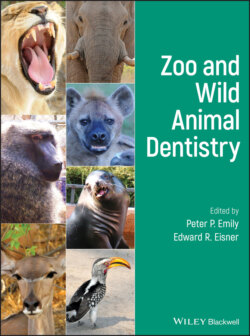Читать книгу Zoo and Wild Animal Dentistry - Группа авторов - Страница 21
Molar Evolution
ОглавлениеThe evolution to the Tribosphenic molar was the signifying molar form particular to mammals. With the exception of the Platypus and the Echidna, all living mammals are descendants of a common stock characterized by tribosphenic dentition. In 1936, Simpson coined the word “tribosphenic” as a replacement for the Cope‐Osbornian “tritubercular” and “tuberculo‐sectorial” descriptions used respectively for essentially euthemorphic upper and lower molars.
In contrast, tribosphenic dentition is not found in any of the mammals that appear in the late Triassic, 190 M.Y.B.C.E. The fossil record of the Jurassic period, 180–35 million years BCE shows instances of convergence. Only in the early Cretaceous, 135–25 million years BCE was there a definite record of mammalian tribosphenic dentition. In the middle to late Cretaceous period, the fossil record shows a major adaptive radiation to this kind of dentition.
By the early Cretaceous period, mammals with fully tribosphenic molars were in existence and had begun to diversify. These early mammals were small carnivores and omnivores. None showed modification of the dentition characteristic of mammalian herbivores, nor did the first mammals with tribosphenic dentition show modifications of mammalian herbivores.
The tribosphenic dentition of early cretaceous mammals was not adapted to the demands of an herbivorous diet. The origin of tribosphenic dentition was one of mammalian adaptation's major changes in the terrestrial flora during this period. The herbivores of the Cretaceous period were rodent‐like creatures that branched off the early mammalian stock before the origin of the tribosphenic dentition. The Cretaceous period was a long 71‐million‐year period, 135–66 million years BCE. This is one‐third the total history of the class of Mammalians. A more rapid dental evolution began during the Cenozoic, 64 million years BCE and evolved without dinosaurian competition.
In 1907, Osborn‐Cope presented four principle tenets of molar evolution that were later revised to a degree by Hershovitz:
First Principle: The primitive tritubercular type. The tritubercular was ancestral to many if not all of the molar teeth.
Second Principle: The origin of the tritubercular type from a single reptilian cone by the addition of lateral denticles.
Third Principle: Cusp addition or differentiation. New denticle cusps or smaller cones on the sides of original reptilian cone added by budding or outgrowth.
Fourth Principle: Reversed upper and lower triangles. In the lower molars, the reptile cone is external and the two denticles internal, while in the upper molars, the reverse is the case [4].
Patterson's view found that a broad shelf labial to the paracone and metacone, carrying a stylocane and other cusps were charlatanistic to primitive tribosphenic upper molars. Stylar shelf forms are still present in some marsupials.
Tribosphenic dentition evolution during the Jurassic period is distinguished by the morphology and function of molariform teeth. The upper molars have the basic trigon, consisting of a paracone, metacone and protocone. A broad shelf labial to the paracone and metacone was characteristic to the primitive tribosphenic upper molar. The lower molars were divided into a higher mesial trigonid formed by three cusps and a lower talonid basin that received the upper protocone. They could produce only two kinds of action during mastication: food could only be crushed between the major segments of the upper and lower molars.
The functions of tribosphenic dentition and the time and place of their origin suggest that their evolution was one of the adaptations of mammals to a diet based on the expanding fauna. The late Cretaceous period saw an increase in the modifications of the tribosphenic molar. The extinction of many mammalian lineages does not seem to be connected to any tooth type or sources of food.
Tooth numbers have evolved from many to few in number. Early mammals tended to have more teeth than recent mammals indicating a reduction in tooth numbers. Hence, in any group, the species with the largest number of teeth is likely to be the most primitive and somewhat less intelligent. However, the modern river dolphin has approximately 206 homodont teeth, but remains one of the more intelligent mammals. Reference the Appendix III Dental Formulas at the back of this book to compare the number of teeth with intelligence.
